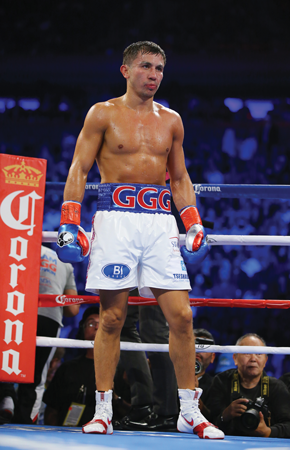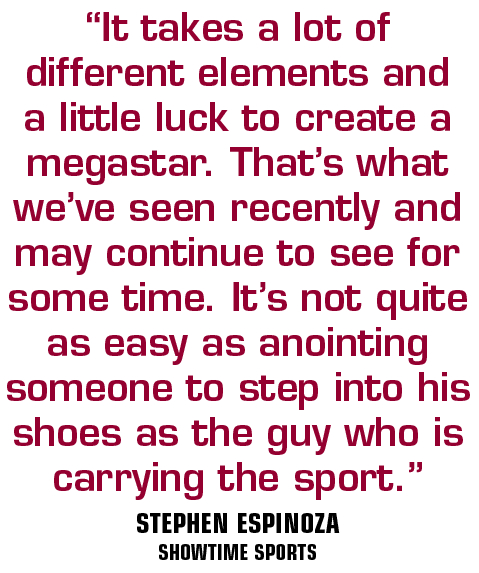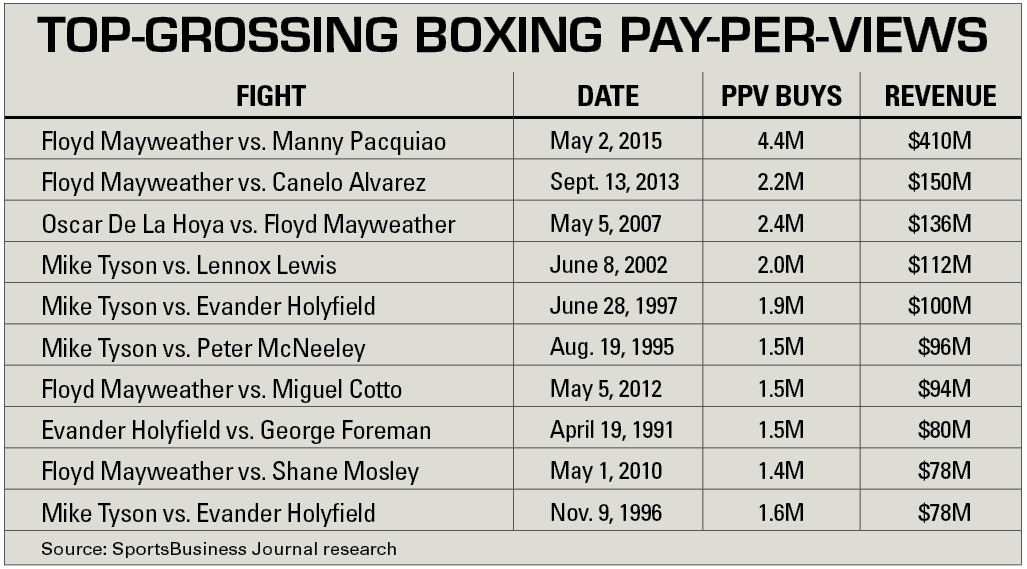The sellout crowd cheered raucously as the image of the champion warming up in his dressing room came onto the screen suspended above the ring at Madison Square Garden, then jeered lustily as the candidate for president stepped into the picture to shake his hand.
Donald Trump may yet win Iowa. But, on this October night, middleweight Gennady Golovkin won New York.
That he prevailed in the ring, dusting hard-punching threat David Lemieux by TKO in the eighth round, was significant to Golovkin’s boxing career in two ways.
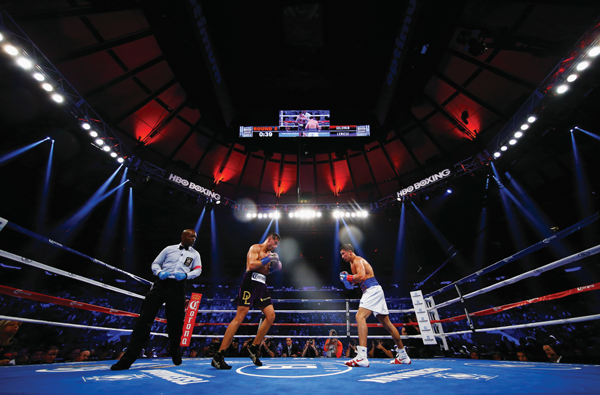 |
Gennady Golovkin (right and below) fights David Lemieux at Madison Square Garden. Golovkin’s win, and the crowd he attracted, will steer him toward more lucrative pay-per-view fights.
Photos by: Getty Images |
Now unbeaten in 34 pro fights, with a streak of 21 knockouts that pre-dates Barack Obama’s presidency, Golovkin added a second world championship belt and an interim title to his résumé, forwarding his path toward more lucrative fights in the most compelling weight class in boxing.
But it was the way he produced at the box office that likely will mean more to his future, and especially his financial future. Golovkin drew a crowd of 20,548, or about 2½ times the 8,752 he attracted for his MSG debut last summer, earned after two solid HBO appearances at the 5,000-seat MSG Theater.
The show did not do especially well on pay-per-view, where it delivered about 125,000 buys and $7 million in revenue on the same night that the New York Mets faced the Chicago Cubs in the playoffs, likely taking a bite out of the fight’s performance in two markets in which boxing pay-per-views typically sell well. But because of the large gate and strong foreign sales, Golovkin promoter Tom Loeffler and Lemieux promoter Oscar De La Hoya both declared they and their fighters fared better financially than they would have had the fight been on HBO.
The decision to cross Golovkin over to pay-per-view paid off, if only modestly.
This was a night of particular interest in the boxing business, not only because Golovkin has the makings of a bankable star, but because the pay-per-view vacuum created by the announced retirements of Floyd Mayweather and Manny Pacquiao begs the question: Who’s next?
The leading candidate is thought to be Canelo Alvarez, who was set to fight Miguel Cotto Saturday night in what almost certainly will be the highest-grossing boxing pay-per-view since Mayweather-Pacquiao in May. After that comes Golovkin, the only other of the up-and-comers who has even taken a stab as a pay-per-view headliner thus far, a fighter who, while popular among fight fans, may be better known among general sports fans as the guy shadow boxing in the latest TV campaign for the Apple watch.
Ask those who have been at this for a while about life after Mayweather and they respond with predictable optimism. There will be a new pay-per-view star because there always has been one, going back to the emergence of the medium 25 years ago, and to the stars whose fights were broadcast in theaters and convention centers for decades before that.
“Since I came into the business, this has been the constant question each time a tentpole fighter has moved on,” said Todd DuBoef, president of Top Rank Boxing, the promotional company that launched the careers of the last three pay-per-view leaders, De La Hoya, Mayweather and Pacquiao. “The good news is, it’s an evergreen model. For some reason, it always naturally gets filled. We may not know who it will be, but it definitely gets filled.”
In the past, there have been definable handoffs. Mayweather and Pacquiao each launched by defeating De La Hoya
— Mayweather on a show that did a then-record 2.4 million buys; Pacquiao on one that did 1.25 million.
The king is dead. Long live the king. That’s how it worked.
This time, the king walked away with his crown, selling $1.3 billion worth of pay-per-views while never losing a fight.
While Mayweather’s replacement won’t have a predecessor to draft behind and then depose, he will benefit from a media environment that allowed Mayweather-Pacquiao to not only break the pay-per-view record, but shatter it to a degree that caused some to rethink what is possible.
“Big picture, the new digital world that we live in is much more conducive to keeping boxers relevant year round, which is a real plus,” said Mark Boccardi, senior vice president of programming and business development for leading pay-per-view distributor In Demand. “Even a few years ago, there would be an enormous amount of buildup for a big fight, the fight would happen, there would be some post-fight analysis and then you wouldn’t hear about the fighters again until the buildup came again for their next fight.
“That has changed dramatically. The fighter continues to live on. Whether it’s in clips of a fight or through the fighter’s own social media presence, just keeping active keeps them relevant.”
In his four pay-per-views before he dethroned De La Hoya in a record-setting fight that generated 2.45 million buys, Mayweather sold at a reliable clip of 325,000 to 350,000. After the De La Hoya fight, he sold, in order, 920,000 (Ricky Hatton), 1.1 million (Juan Manuel Marquez), 1.4 million (Shane Mosley), 1.24 million (Victor Ortiz), 1.5 million (Miguel Cotto) and 2.2 million (Alvarez), before dropping back to 925,000 against Marcos Maidana in the fight that set the stage for him to face Pacquiao — largely because he was the only opponent left who might help generate big bank.
In his last fight, against Andre Berto, Mayweather fell to less than 500,000.
“The public doesn’t buy a fighter; the public buys a fight,” said Mark Taffet, president of HBO pay-per-view, who has been with the division since its launch in 1991. “While megastars may have a floor that’s higher than other fighters, they only reach their ceilings in the great fights that are recognized by the public as such. That’s why great fighters have to have great rivals to really cash in.”
The fact that Mayweather’s ceiling was so lofty, and his floor so sturdy, makes you wonder what comes next.
“What we have learned and will continue to learn in the near future following Floyd’s retirement is that it’s not as easy as it looked,” said Stephen Espinoza, executive vice president of Showtime Sports. “Perhaps because of Floyd’s enormous success and huge social following that the force of his personality generated, we’ve all gotten a little spoiled. And now it’s a return to reality. It takes a lot of different elements and a little luck to create a megastar.
That’s what we’ve seen recently and may continue to see for some time. It’s not quite as easy as anointing someone to step into his shoes as the guy who is carrying the sport.”
Developing stars
As the bell sounded to start the first round of the opening fight on the card, the man who books fights into Madison Square Garden sat in an event-level suite, a college football game playing in the background, explaining the momentum that has built behind Golovkin in New York.
Joel Fisher, executive vice president of MSG Sports, remembers Loeffler calling him to say he had signed Golovkin and was bringing him to the United States. As the U.S. promoter for heavyweight champions Vitali and Wladimir Klitschko, Loeffler had visions of marketing heavily to the many Eastern Europeans in New York, as he had with the Klitschkos.
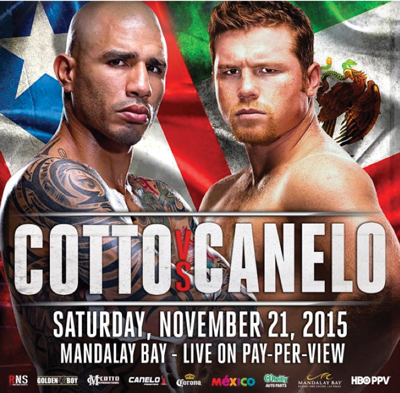 |
| The bout between Miguel Cotto and Canelo Alvarez in Las Vegas was expected to be the second highest grossing pay-per-view boxing match of the year. |
Fisher remembered seeing Golovkin in the Olympics. He met with Loeffler and Golovkin in his office, then hosted them at a Rangers game.
“We didn’t know how good he was going to be at the time,” Fisher said. “But we liked him and Tom was really convinced he’d be a great fighter. We figured we’d give it a shot.”
That shot has paid off for both Golovkin and MSG. Not only has he given MSG a star who can fill the Garden — at least when the seats are priced at $50 upstairs and $100 to $200 downstairs, as they were for the Lemieux fight — Golovkin also filled the 12,000-seat Forum in Los Angeles, another building MSG owns. The 6,000 tickets Golovkin sold during the pre-sale for the Lemieux bout were the most ever for a fight at MSG. It took only a week for it to eclipse 15,000.
“We see this as a whole other group of people than we typically see. It’s general boxing fans,” Fisher said. “When Miguel Cotto sold out here, we knew it was a lot of Puerto Ricans. For this, it’s all over the map. That’s the beauty of this. You’ve got him mobilizing fans of the whole boxing universe.”
Earlier in the evening, sitting down to dinner at a steak house near the back entrance at MSG, HBO vice president Tammy Ross connected the dots between the date at the Garden and Golovkin’s first try at a pay-per-view.
“This particular fight, I don’t know if it would have sold out the Garden if it had been on HBO rather than pay-per-view,” Ross said. “The pay-per-view aspect of it elevates it. The publicity. The marketing money that goes behind this fight. It conveys a different message to the fan, because it’s supposed to be special if it’s on pay-per-view.
Regular fights are not on pay-per-view. So this must not be a regular fight.”
Each sport has cues that signal the import of its events. The leagues have playoffs and championship games. Tennis and golf have their majors. Auto racing has iconic venues, such as Daytona, Indianapolis and Monaco.
Boxing has no fixed schedule. Its championships are muddled by a confusing melange of sanctioning bodies. By default, the marker for its bigger events has become pay-per-view.
Loeffler was confident that, with the date at MSG secured, Golovkin could move to pay-per-view with limited risk.
He wasn’t likely to hit a home run in his first time out, but he was insured against an utter flop. Though there wasn’t much upside financially, there was an opportunity to build Golovkin’s profile.
“The advantage of the pay-per-view is that the marketing budget is much higher than for a regular HBO fight,” Loeffler said. “We had the promotional tour. The whole advertising budget for the pay-per-view. The face-off. So it’s not just the pay-per-view revenue. It’s the exposure that you get from being associated with it. Even if a million people don’t buy it, millions are hearing and reading about it.
“A lot of people are hyper-focused on the pay-per-view numbers, but take into account that ticket revenue and sponsorships were higher than ever for Gennady. International [TV rights] were the highest we’ve ever had.
“Even if we hadn’t made any money on the show, it achieves our objective. Our objective with Gennady is a long-term plan. His priority is to unify all the titles. Even if he made zero money on the show, it would be a success in terms of his career.”
Loeffler knows that, even considering his fighter’s burgeoning popularity, the real money lies in getting Golovkin in the ring with either Alvarez or Cotto. A couple of weeks before those two squared off in Las Vegas in the sort of Mexico vs. Puerto Rico matchup that has done solid pay-per-view numbers time after time, Loeffler took Golovkin on a promotional swing through Texas, where he appeared in a plaza in San Antonio and on the field before a Dallas Cowboys game.
The motivation was clear. Golovkin’s best chance of fighting the winner of Alvarez-Cotto is to show that he can help sell tickets, pay-per-views or both. If that’s Cotto, the likely venue would be the Garden, which both fighters have sold out. If it’s Alvarez, the bout likely would be held in Las Vegas, San Antonio, Houston or Dallas.
“With everything we do, we’re building his fan base and building his brand,” Loeffler said. “We’ve built him on the East Coast. We’ve built him on the West Coast. Now, we’ll build him in Texas. … We’re at a point where other fighters can no longer say it’s too much risk to fight Golovkin and not enough money.”
The shift to pay-per-view
Up until now, all the leading pay-per-view sellers — Evander Holyfield, Mike Tyson, De La Hoya, Mayweather and Pacquiao — have emerged out of the lineage of a predecessor.
The first pay-per-view produced and distributed by HBO was Holyfield’s upset of George Foreman in 1991. The concept of paying to watch a fight broadcast was nothing new. In fact, most of the bigger fights of the 1960s, ’70s and ’80s aired live exclusively on closed-circuit, playing in movie theaters and convention centers.
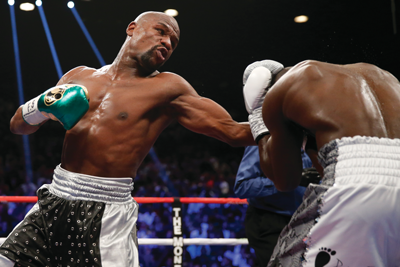 |
Mayweather said that his September fight against Andre Berto was his last, creating a major void in the pay-per-view market.
Photo by: Getty Images |
Sugar Ray Leonard fought in prime time on ABC and on HBO in the ’80s, but when he fought Roberto Duran, Tommy Hearns and Marvin Hagler, all of those bouts were on closed circuit, as were all of Muhammad Ali’s big fights throughout the ’60s and ’70s.
“People were willing to pay for boxing; to get in their car and drive to go watch boxing,” Taffet said. “However, they were watching it on screens where the picture quality was poor, where there was barely any sound, and where the food and beverage options were less than desirable. What we recognized was that [in-home] pay-per-view was a massive improvement in consumer experience over the closed-circuit environment which preceded it.”
Holyfield and Tyson descended from the lineage of iconic American heavyweights who fought on closed circuit.
Holyfield sold well in his big fights, but it was Tyson who emerged as the first to generate massive numbers — often in excess of 1 million buys — regardless of the opponent, attracting an audience based on an unpredictability that bordered upon chaos.
The first fighter from the lower weight classes to break through as a pay-per-view megastar was De La Hoya, who captivated the Olympic audience with an emotional backstory, bringing home gold as he had promised his mother, who died of breast cancer two years earlier. De La Hoya’s rise came as Hispanics were rising as an economic engine. He tapped into their heritage in ways no other athlete did at that time.
Mayweather changed the way pay-per-view fights were sold, building a deep connection with viewers by letting them into his life as no athlete had before, first through the “24/7” shows that aired on HBO in the lead-up to his fights, and then via social media just as the new medium was blowing up.
Pacquiao was already popular as a niche fighter, but when his story gained broader exposure through those same platforms, he too emerged as a star in his own right.
“Personally, my theory is that the three biggest pay-per-view stars of my lifetime were all a direct result of demographic and societal shifts,” Espinoza said. “Mike Tyson’s rise coincided with the birth and growth of hip-hop culture. Oscar’s rise coincided with the recognition of the economic power of the Latino demographic. Floyd’s coincided with social media.
“Not that they didn’t play a role in it. Floyd, for example, took advantage of social media better than any athlete has. But in each case, these huge stars were boosted by societal and cultural changes that gave the additional wind to their sails in terms of making them megastars.
“As much as people like to make it look like science and take credit for it, there is a significant amount of luck in the star-building process.”
Another wild card is the impact of Premier Boxing Champions, the series launched in March by fight manager Al Haymon, who through a massive set of time buys brought boxing back to the broadly distributed networks that carry the most sports, including NBC, CBS, ESPN and Fox.
PBC executives declined to comment for this story. But in an interview earlier this year, former Chief Operating Officer Ryan Caldwell made it clear that developing pay-per-view stars is not among the organization’s short- or medium-term priorities.
“It’s not evident to us if you go past [Mayweather and Pacquiao] that there has been a real sustainable pay-per-view star that’s emerging underneath them,” said Caldwell, who left the PBC to launch an investment fund but remains an engaged adviser. “I don’t know that that’s so much boxing’s problem as the medium of pay-per-view, in that it’s tough when you’re not the premium sport in the country to be the price leader in access to content.
“We did the math on this. For the average boxing fan, between the two premium cable channels and the number of pay-per-views in 2014, you’re asking the average fan to pay $1,300 a year to view your sport. That’s an incredibly self-defeating proposition. We need to be far more broadly distributed to try to reach our core fan base and then grow into pay-per-view and premium cable — and not likely for a long time.”
Lou DiBella, the fight promoter who started his career in the sport as an HBO executive, turned the question of the next pay-per-view star upside down.
“If boxing wants to really become relevant again, it can’t be about building pay-per-view stars,” said DiBella, who negotiated fights for HBO when the network got into the pay-per-view business. “It has to be about building stars and putting them on networks where everyone can see them. The point isn’t to create a pay-per-view star. It’s to elevate the sport. The Super Bowl and the World Series are on free television. I don’t think the be-all and end-all of a sport should be pay-per-view.”
Of course, DiBella knows that, even if the PBC were to secure a rights deal based upon the 1.5 million to 4 million viewers watching its fights on the broader networks, it will be years, maybe decades, before the finances match the upside of the bigger pay-per-views.
In one night, Mayweather-Pacquiao brought in upward of $500 million in revenue, which is about what Fox pays each year to televise Major League Baseball.
“In light of recent events, the goal line may be a little distorted,” Espinoza said. “When we as a sports industry and the athletes individually look at the mind-boggling financial results of Floyd’s recent fights, it’s hard not to use that as the standard by which all future successes are going to be measured. People need to realize that it didn’t happen for Floyd overnight. It was a long, long process. It was a combination of multiple factors, some of which cannot be replicated.
“The proper approach is to focus on elevating the sport and its elite participants and continuing to grow the popularity of both of those. And then, with a little luck … .”
In his hotel suite on the afternoon of the Golovkin-Lemieux fight, the retired pay-per-view star who now promotes Alvarez contemplated the road ahead.
“Not every fighter can become a pay-per-view star,” said De La Hoya, who as Alvarez’s promoter has gone from being a pay-per-view star to trying to build one. “Just because you’re on network TV doesn’t mean you’re going to become a pay-per-view star. The pay-per-view industry is a whole different animal. In order to have people shell out $50 or $60 or $70, it takes something special. Canelo has that it factor. People gravitate toward him. And they don’t mind shelling out money to see him fight. Just like Mayweather. Like myself. Like Pacquiao. We have something special.
“And it doesn’t come around very often.”
7 steps to becoming a megastar
Mark Taffet has been with HBO’s pay-per-view division since it launched in 1991 behind Evander Holyfield’s upset of George Foreman. The HBO pay-per-view president identified seven factors that set apart pay-per-view “megastars,” as he calls them:
■ In-ring style: The ability to entertain, and especially to knock out an opponent at any point in the fight.
■ Out-of-ring persona: Not simply a large or likable personality, but a distinct persona that sets a fighter apart from most others of his generation.
■ Natural rivalries: Other fighters who pose a threat in the same or an adjacent weight class.
■ Demographics: A match with a group that will follow a fighter because they identify with him.
■ Media/technology: The savvy use of all available tools to build popularity and convert it into commerce.
■ Intent: The willingness to work as hard to build a fan base as they do to become great fighters.
■ “It” factor: An intangible, difficult to describe quality that allows a fighter to connect deeply with consumers, driving them not only to watch, but pay to watch; often a storyline that is unique and memorable, shared openly and authentically.
“The question for this next set of fighters,” Taffet said, “will be whether they can demonstrate that in-ring style, if they can have that out-of-ring persona, if they can not only find but take on the natural rivals that boxing fans require and respect, and if they have the willingness to exploit the digital and social media age which allows fighters to reach fans more directly than any of their predecessors.”



